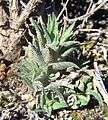Haworthia venosa
| Haworthia venosa | |
|---|---|
| | |
| Haworthia venosa var. tessellata at the botanical garden of Villa Durazzo-Pallavicini, Genova Pegli | |
| Scientific classification | |
| Kingdom: | Plantae |
| Clade: | Angiosperms |
| Clade: | Monocots |
| Order: | Asparagales |
| Family: | Asphodelaceae |
| Subfamily: | Asphodeloideae |
| Genus: | Haworthia |
| Species: | H. venosa |
| Binomial name | |
| Haworthia venosa (Haw.) Haw. | |
| Synonyms | |
Haworthia venosa is a species of flowering plant in the genus Haworthia belonging to the family Asphodelaceae, native to Namibia and South Africa.
Naming and taxonomy
The genus name Haworthia honors the British botanist Adrian Hardy Haworth (1767–1833), while the species name venosa means "veined”.[1]
Within the genus Haworthia, the species forms part of the subgenus Hexangulares. More specifically, it falls within section Venosae (together with its close relatives, Haworthia limifolia, Haworthia koelmaniorum and Haworthia woolleyi).
Recent phylogenetic studies have demonstrated that subgenus Hexangulares is actually relatively unrelated to other Haworthias (being more closely related to Gasterias. It will therefore comprise a new, separate genus, Haworthiopsis, and this species will accordingly become "Haworthiopsis venosa".[2][3]
Subspecies
Depending on the authority, these are either considered subspecies of venosa, or as independent (but closely related) species in their own right:
- H. venosa subsp. granulata (Marloth) M.B.Bayer. A rare form from the south-west of its range.
- H. venosa subsp. tessellata (Haw.) M.B.Bayer. The most common form.
- H. venosa subsp. venosa. The rare type form, from an isolated population to the south.
- H. venosa subsp. woolleyi (Poelln.). A slender, gracile form from the far south-east.
 Haworthia venosa subsp. granulata
Haworthia venosa subsp. granulata Haworthia venosa subsp. tessellata.
Haworthia venosa subsp. tessellata. Haworthia venosa subsp. venosa.
Haworthia venosa subsp. venosa.
H. venosa subsp. tessellata is the form most popular in cultivation, due to its attractive, splayed, compact leaves. It has also gained the Royal Horticultural Society's Award of Garden Merit.[4]
Description
It is a mat-forming succulent evergreen perennial reaching 8–60 cm (3–24 in) in height. Stemless rosettes of 12-15 fleshy, triangular, lanceolate, dark green leaves show a few pale green lines along the upper surfaces and small teeth along the margins.
In spring (November to December) it bears 15 cm (6 in) long stems of green-white, tubular flowers in racemes.[5]
Distribution
This species occurs over a large area, from the inland Karoo and Namibia to as far south as the norther part of the Breede River valley. Here it occurs on rocky slopes.
Cultivation
In cultivation it requires a minimum temperature of 10 °C (50 °F), so is grown under glass in temperate locations.[6]
References
- ↑ Harrison, Lorraine (2012). RHS Latin for gardeners. United Kingdom: Mitchell Beazley. p. 224. ISBN 9781845337315.
- ↑ Manning, John; Boatwright, James S.; Daru, Barnabas H.; Maurin, Olivier; van der Bank, Michelle. A Molecular Phylogeny and Generic Classification of Asphodelaceae subfamily Alooideae: A Final Resolution of the Prickly Issue of Polyphyly in the Alooids? Systematic Botany, Volume 39, Number 1, March 2014, pp. 55-74
- ↑ http://www.haworthia.org.uk/haworthia.htm
- ↑ "RHS Plant Selector - Haworthia venosa subsp. tessellata". Retrieved 17 July 2013.
- ↑ RHS A-Z encyclopedia of garden plants. United Kingdom: Dorling Kindersley. 2008. p. 1136. ISBN 1405332964.
- ↑ Haworthia venosa - Information page at Haworthia-Gasteria
| Wikispecies has information related to: Haworthia venosa |
| Wikimedia Commons has media related to Haworthia venosa. |